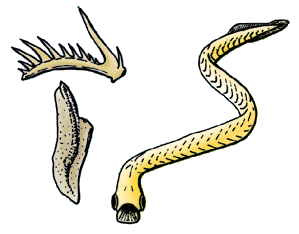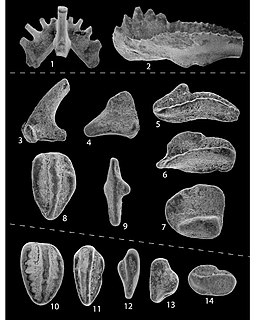
Conodonts are extinct agnathan chordates resembling eels, classified in the class Conodonta. For many years, they were known only from tooth-like microfossils found in isolation and now called conodont elements. Knowledge about soft tissues remains limited. The animals are also called Conodontophora to avoid ambiguity.
The Darriwilian is the upper stage of the Middle Ordovician. It is preceded by the Dapingian and succeeded by the Upper Ordovician Sandbian stage. The lower boundary of the Darriwilian is defined as the first appearance of the graptolite species Undulograptus austrodentatus around 467.3 million years ago. It lasted for about 8.9 million years until the beginning of the Sandbian around 458.4 million years ago.
Richard John Aldridge was a British palaeontologist and academic, who was Bennett Professor of Geology at the University of Leicester.
The Pander Society is an informal organisation founded in 1967 for the promotion of the study of conodont palaeontology. It publishes an annual newsletter. Although there are regular meetings of the Pander Society, at the Annual Meeting of the Geological Society of America, at European Conodont Symposia, and elsewhere, any meeting of three or more "Panderers" is considered an official meeting of the "Pander Society". The society is headed by the Chief Panderer, currently Maria Cristina Perri of the Università di Bologna. The society confers two awards, the Pander Medal for a lifetime of achievement in conodont palaeontology, and the Hinde Medal for an outstanding contribution to conodont palaeontology by a young Panderer.
Archaeognathus is a fossilized jaw apparatus from the Ordovician that has been compared to the conodonts and vertebrates, yet remains unclassified.
Prioniodontida, also known as the "complex conodonts", is a large clade of conodonts that includes two major evolutionary grades; the Prioniodinina and the Ozarkodinina. It includes many of the more famous conodonts, such as the giant ordovician Promissum (Prioniodinina) from the Soom Shale and the Carboniferous specimens from the Granton Shrimp bed (Ozarkodinina). They are euconodonts, in that their elements are composed of two layers; the crown and the basal body, and are assumed to be a clade.
Westergaardodina is a species-rich genus of spine, U or W-shaped paraconodont known from Middle Cambrian to Lower Ordovician strata.
Maurits Lindström was a Swedish geologist and paleontologist. Lindströms initial work was divided among two topics conodont paleontology and the structural geology of the Scandinavian Caledonides in Lappland.
Elictognathidae is an extinct conodont family.
Idiognathodus is an extinct conodont genus in the family Idiognathodontidae.

Gnathodus is an extinct conodont genus in the family Idiognathodontidae.
Amorphognathus is an extinct conodont genus in the family Balognathidae from the Ordovician.
Distomodontidae is an extinct family of conodonts.
Walter C. Sweet was an American paleontologist.
Stig M. Bergström is a Swedish-American paleontologist.
Appalachignathus is a genus of multielement conodonts from the Middle Ordovician of North America.
Rhipidognathidae is a family of multielement conodonts from the Ordovician.
Prioniodus is an extinct genus of conodonts in the family Balognathidae from the Ordovician.
Histiodella is an extinct genus of conodonts.
Protoconodonts are an extinct taxonomic group of conodonts or, possibly, Chaetognaths.

